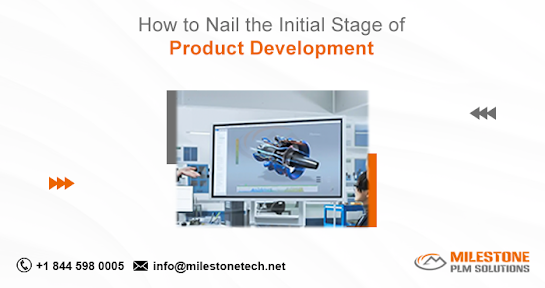How to Nail the Initial Stage of Product Development
In the product development process, each phase plays a crucial role in bringing an idea to life. One of the most pivotal steps is the concept stage of product development. While the idea stage lays the groundwork, the concept stage is where those initial thoughts are refined, fleshed out, and evaluated for viability. Getting this stage right can make the difference between a product that thrives in the market and one that fails to meet expectations.
In this blog, we'll explore the steps and strategies that can help ensure success during the concept stage of product development.
1. Understand the Market and User Needs
The concept stage of product development requires a deep dive into understanding your target market and the specific needs of potential users. By gathering insights from market research and customer feedback, you can better define how your product concept fits into the larger picture. Who are your users? What problems do they face? How does your product solve those problems in a way that no other product does?
Successful companies know that a great product is not just about having innovative features—it’s about meeting a genuine need. If your concept doesn't align with what customers want, even the best execution won’t save it from failure. This stage is the time to sharpen your focus and ensure that your concept is built around solving real, meaningful problems.
2. Refine the Core Features
One common mistake during the concept stage of product development is trying to include too many features at once. It’s tempting to create an all-encompassing product that does everything, but this approach often dilutes the core value of the product.
Focus on identifying the core features that will deliver the most value to your users. Start by asking: what problem does this product solve, and which features are critical to solving it? Once you have defined the essentials, you can prioritize other "nice-to-have" features for future iterations. This way, your initial product will be more streamlined, efficient, and focused on delivering its key promise.
3. Create Prototypes and Validate the Concept
The concept stage of product development is where abstract ideas begin to take on a tangible form through prototypes. Whether it’s a physical model, wireframe, or digital mock-up, creating a prototype allows teams to see and interact with the product, making it easier to spot potential issues early on.
Prototyping is also a valuable tool for concept validation. By sharing prototypes with stakeholders and potential users, you can gather essential feedback. This input can highlight flaws or areas for improvement, enabling you to refine the concept before investing heavily in production. Concept validation through testing reduces the risks of costly redesigns later in the development process.
4. Evaluate Feasibility
An idea may seem brilliant in theory, but it needs to be feasible in practice. During the concept stage of product development, evaluating the feasibility of your concept is critical. This includes analyzing the technical feasibility, financial constraints, and time-to-market considerations.
Ask questions like:
- Can the necessary technology support the product's core functionality?
- Is the production process scalable?
- Can the project be completed within budget and time constraints?
Conducting a thorough feasibility assessment at this stage can help you identify potential roadblocks early and make more informed decisions about whether to move forward, adjust the concept, or explore alternatives.
5. Consider the Product’s Unique Value Proposition (UVP)
Your product's success hinges on how well it differentiates itself from competitors. During the concept stage of product development, it's crucial to clearly define your product’s unique value proposition (UVP). What makes your product stand out in the market? Why should customers choose it over other available options?
A strong UVP should emphasize the key benefits that matter most to your target audience. These benefits can be related to performance, user experience, cost-efficiency, or any other factor that adds value for your customers. Defining the UVP early ensures that your concept is focused and that your product development efforts are aligned with what matters most in the marketplace.
6. Set Clear Goals and Metrics for Success
Defining what success looks like is critical at every stage of product development, and the concept stage is no exception. Setting clear goals for your product's performance helps guide the development process and provides a benchmark for measuring progress.
These goals should be specific, measurable, and realistic. For example, your product could aim to capture a certain percentage of market share, solve a specific problem for a set number of users, or hit a particular revenue target. By establishing metrics for success, you give your team a clear target to work toward and can more easily measure whether the product is meeting expectations as it moves through subsequent stages of development.
7. Collaborate with Stakeholders and Cross-functional Teams
The concept stage of product development isn’t just about defining the product—it’s about collaboration. Bringing in cross-functional teams, including engineers, designers, marketing, and business development professionals, is essential to creating a product that is technically sound, market-ready, and aligned with the company’s broader goals.
Effective collaboration with stakeholders ensures that each aspect of the product is considered from multiple perspectives. Regular communication helps avoid misalignments, fosters innovation, and ensures that the final concept is realistic and actionable. Each team brings valuable insights that can help identify potential challenges or opportunities, making it easier to develop a more robust product.
Conclusion
Succeeding in the concept stage of product development requires a balance of creativity, market understanding, technical feasibility, and collaboration. By focusing on refining the core idea, validating it with prototypes, assessing its feasibility, and defining a strong unique value proposition, businesses can create a solid foundation for the product's subsequent development stages. Ultimately, a well-executed concept stage can set the tone for a product that is not only innovative but also poised for success in the marketplace




Comments
Post a Comment